Club competitions are over and now we hit the summer with international games. The Women’s World Cup has just started and already taking the internet by storm; so did the Nations League. Portugal, Switzerland, Netherlands, and England topped their own groups thus advancing to the Nations League’s inaugural edition semifinals. Having said that, hosts Portugal have already booked their place in the final match with a convincing 3–1 win against Switzerland; thanks to Cristiano Ronaldo’s masterclass.
In the last 12 months, the Netherlands and England showed promising performances in the international stages. De Oranje came to this semifinal after defeating current and former World Cup champions France and Germany in their group. Meanwhile, The Three Lions continued their rising form by sending Spain and Croatia home after clinching the World Cup semifinal last year.
Both teams demonstrate their quality in this match and forced the game to be played for two hours. However, a couple of defensive errors by England allowed the Netherlands to bag two additional goals in the extra time; thus giving the final ticket to the men in orange. This tactical analysis will tell you how Ronald Koeman’s Netherlands defeated Gareth Southgate’s England in this thrilling contest.
Lineups
The Netherlands started with 4–3–3 in this game. Jasper Cillessen started between the sticks; protected by Denzel Dumfries, Virgil van Dijk, Matthijs de Ligt, and Daley Blind in front of him. Barcelona’s new player Frenkie de Jong started alongside Marten de Roon and Champions League winner Georginio Wijnaldum in the middle of the park. The trio of Steven Bergwijn, Memphis Depay, and Ryan Babel led the frontline. Names like Davy Pröpper, Kevin Strootman, and Quincy Promes were in the bench.
England also fielded 4–3–3 for this match. However, none of the players that participated in the Champions League final started the game for The Three Lions. Goalkeeper Jordan Pickford was supported by Kyle Walker, John Stones, Harry Maguire, and Ben Chilwell. In the engine room, West Ham star Declan Rice was flanked by Fabian Delph and Europa League winner Ross Barkley. Upfront, Dortmund sensation Jadon Sancho was chosen to start alongside Marcus Rashford and Raheem Sterling. Harry Kane, Jordan Henderson, and Dele Alli had to start the game from the dugout.
Fluid shapes from both teams
In the first half, England used 4–1–4–1 when they didn’t have the ball. They put their wingers wide and high in order to prevent the ball to be played into Netherlands’ full-backs. Rice was their deepest midfielder and tasked to control the area between the lines.
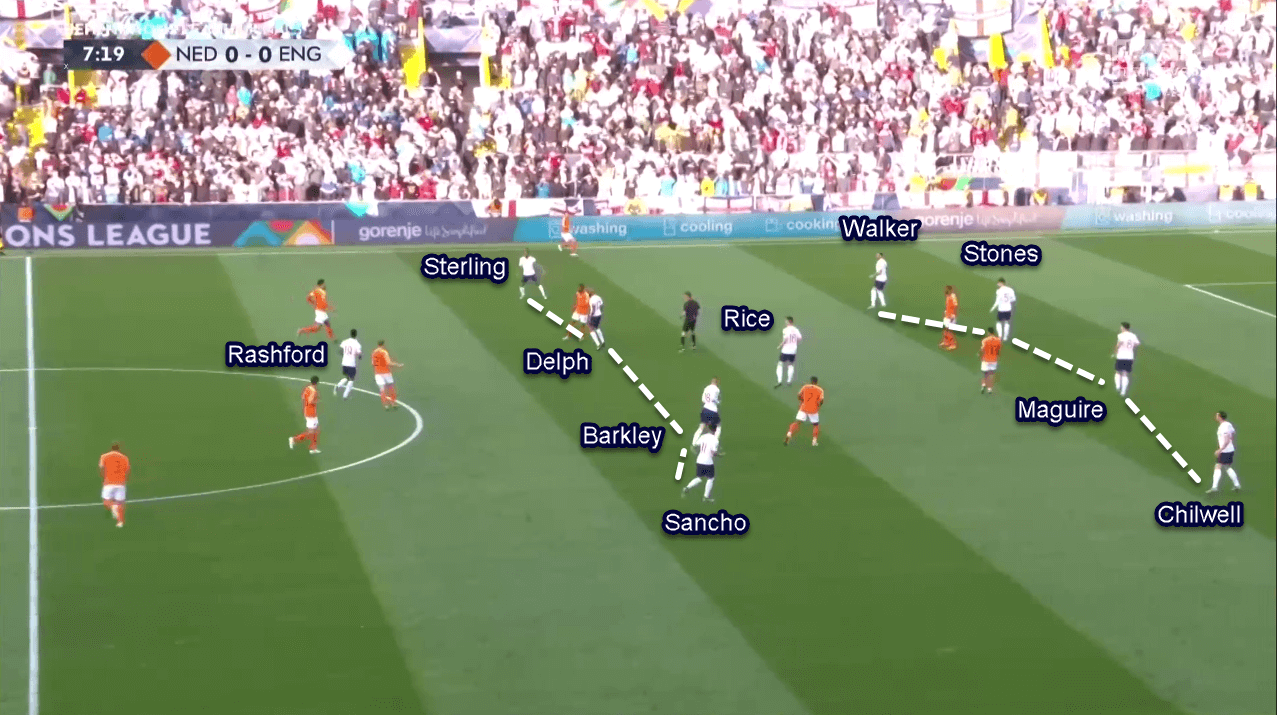
The Netherlands reacted to England’s shape by shifting into 3–1–4–2 or 3–4–3. In this shape, de Jong dropped to play as an LCB while van Dijk and de Ligt shifted accordingly. Their full-backs Dumfries and Blind, then tasked to go high and provide the width; while the attackers tuck inside and positioned in between the lines. They did this in order to stretch England’s midfield block; therefore opening a passing lane to one of the midfielders in between the lines.
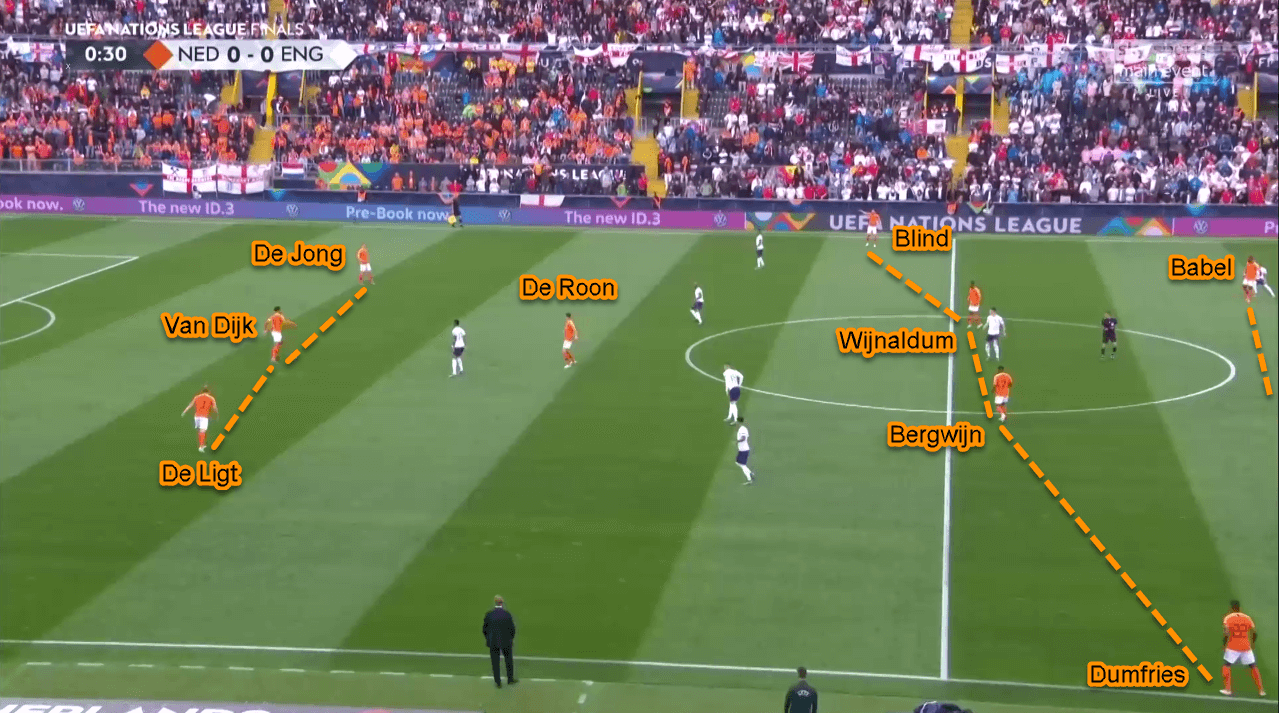
Dutch defence (and its issue)
The Netherlands displayed astute defensive display since the first minute. Koeman instructed his team to play a man-oriented high press to disrupt the Englishmen build-ups. When they didn’t have the ball, the Netherlands shifted into 4–2–3–1 shape and mirrored England’s midfield structure.
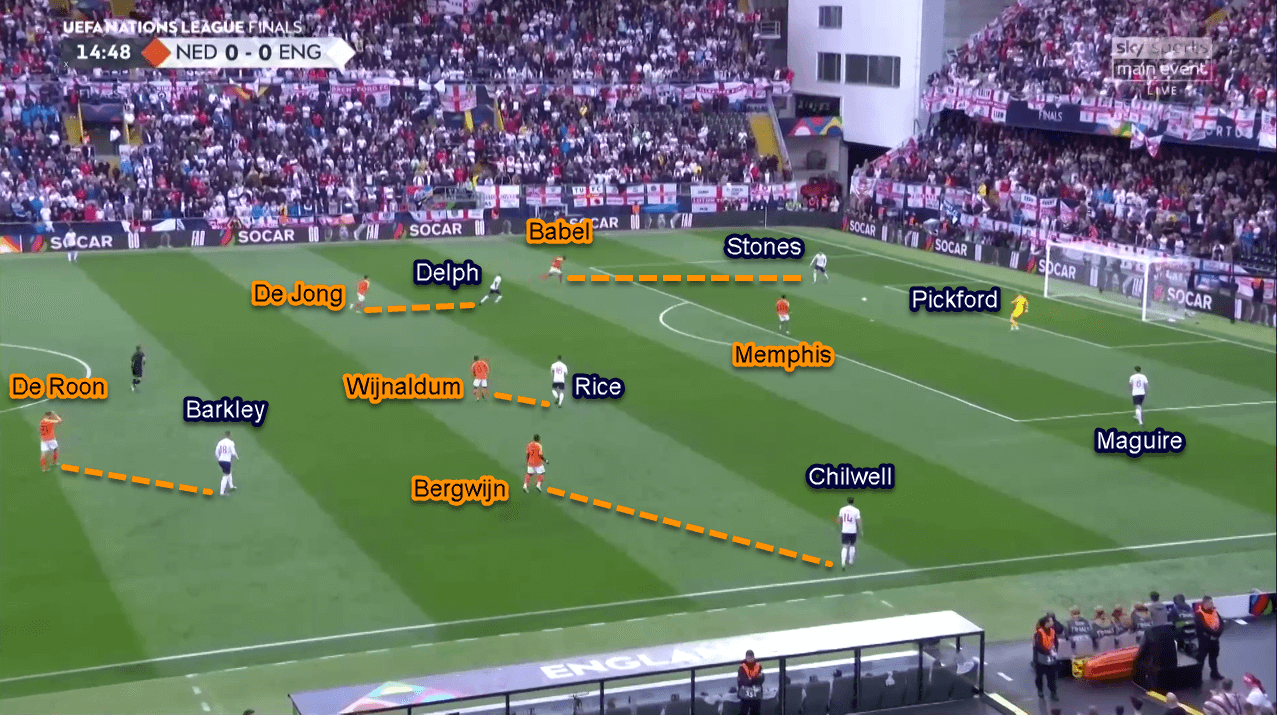
In that new formation, de Jong and de Roon stepped up and help Wijnaldum in closing Delph, Barkley, and Rice respectively. Babel and Bergwijn were tasked to come inside and use cover shadows to prevent the ball to be played to Walker or Chilwell. In the central lane, Memphis was also instructed to use his cover shadow so England’s centre-backs couldn’t play to each other. This defensive set-up worked brilliantly and resulted in England playing a lot of backward passes.
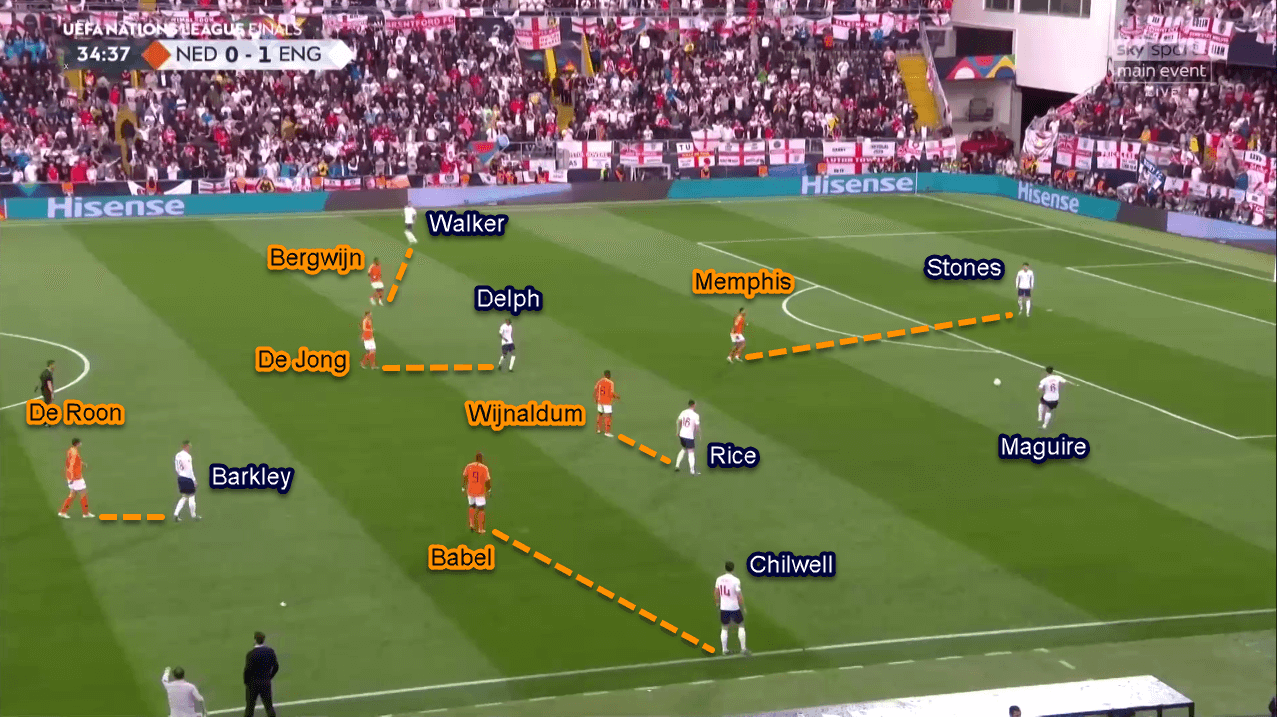
The man-oriented press had its natural issue which opens spaces behind the defensive players who committed forward to follow his man, and this happened to the Netherlands. Both de Jong and de Roon were often pulled out of their positions due to the dropping movements of Delph and Barkley.
The sequence would open a huge space in between the lines for England’s forwards to exploit; which was utilised by England’s forwards for a couple of times. One of the midfielders would drift aside to open a passing lane for the on-ball centre-back to find the dropping striker. However, Dutch’s centre-backs were disciplined and happy to follow their rivals; therefore forcing another backward pass.
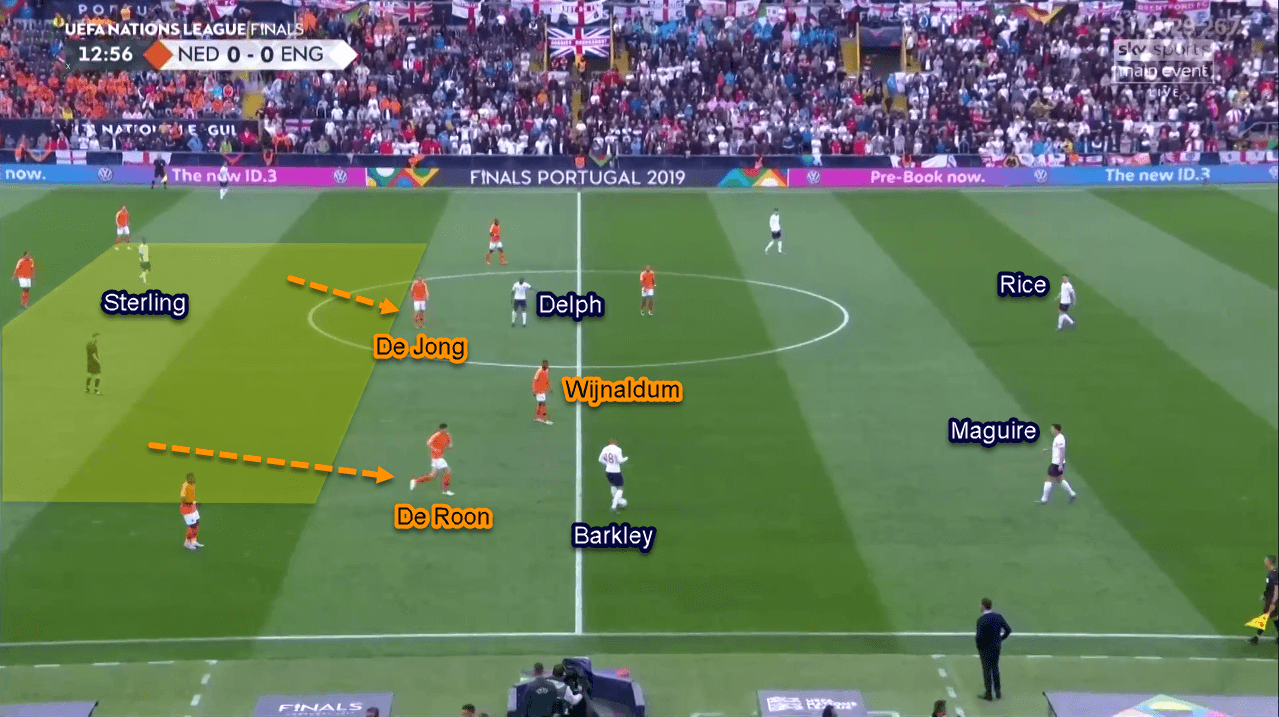
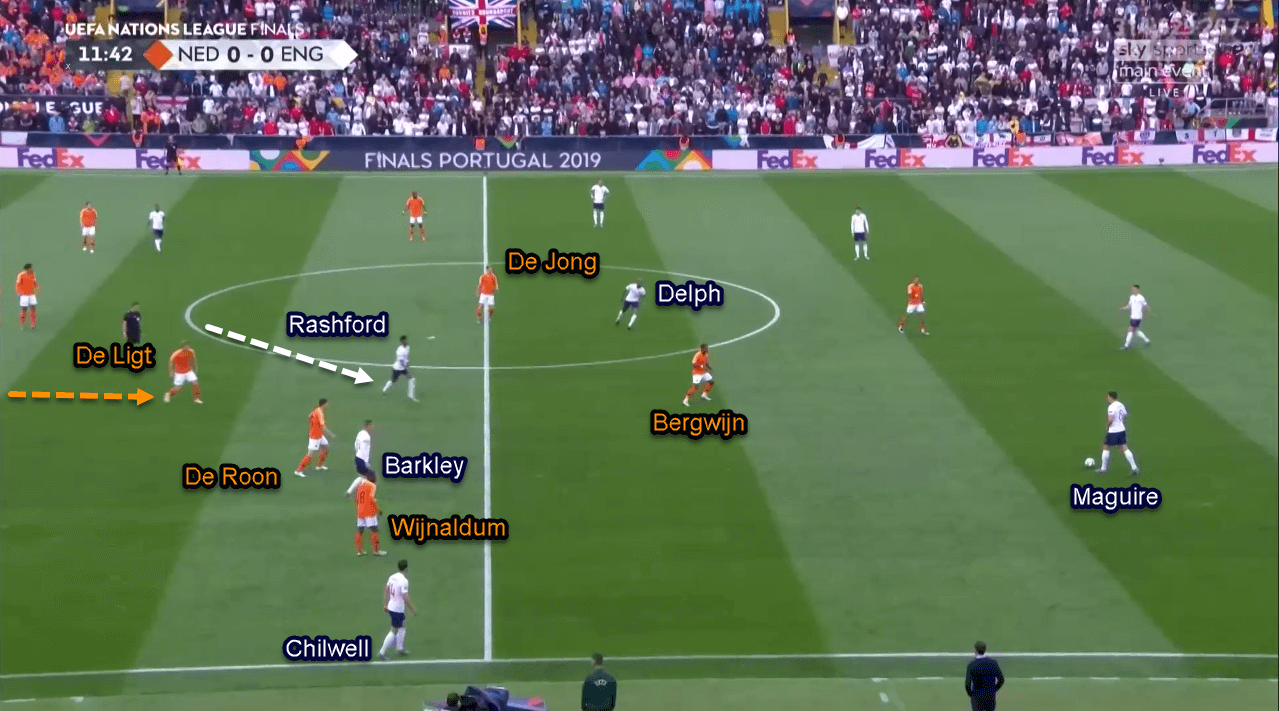
England’s minimum answer
In the opening part of the game, Barkley was positioned higher than his midfield partners. This positioning did allow him to exploit the area between the lines; thus creating clearer combination routes with Sancho and Sterling. Barkley’s ball-carrying ability and good vision enabled him to find one of the attackers in behind, especially in the first quarter hour. However, the lack of creativity of Rice and Delph forced him to drop and help his partners more often; therefore decreasing his offensive threats.
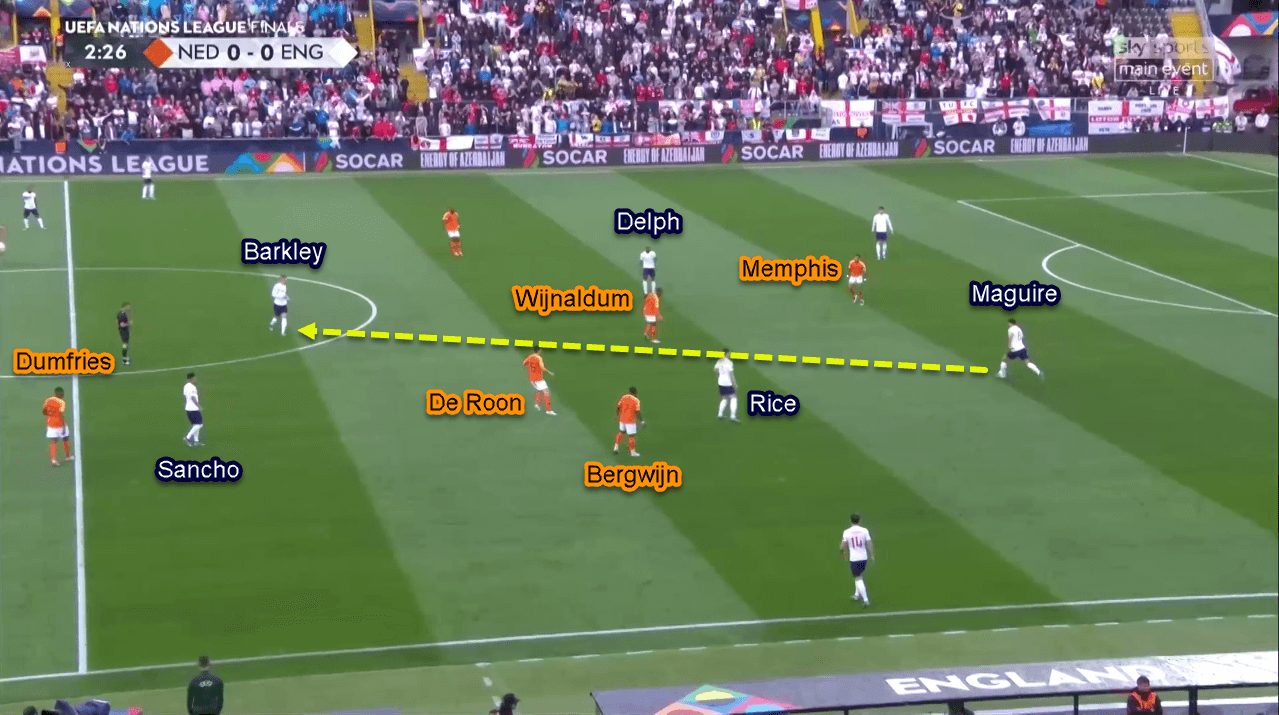
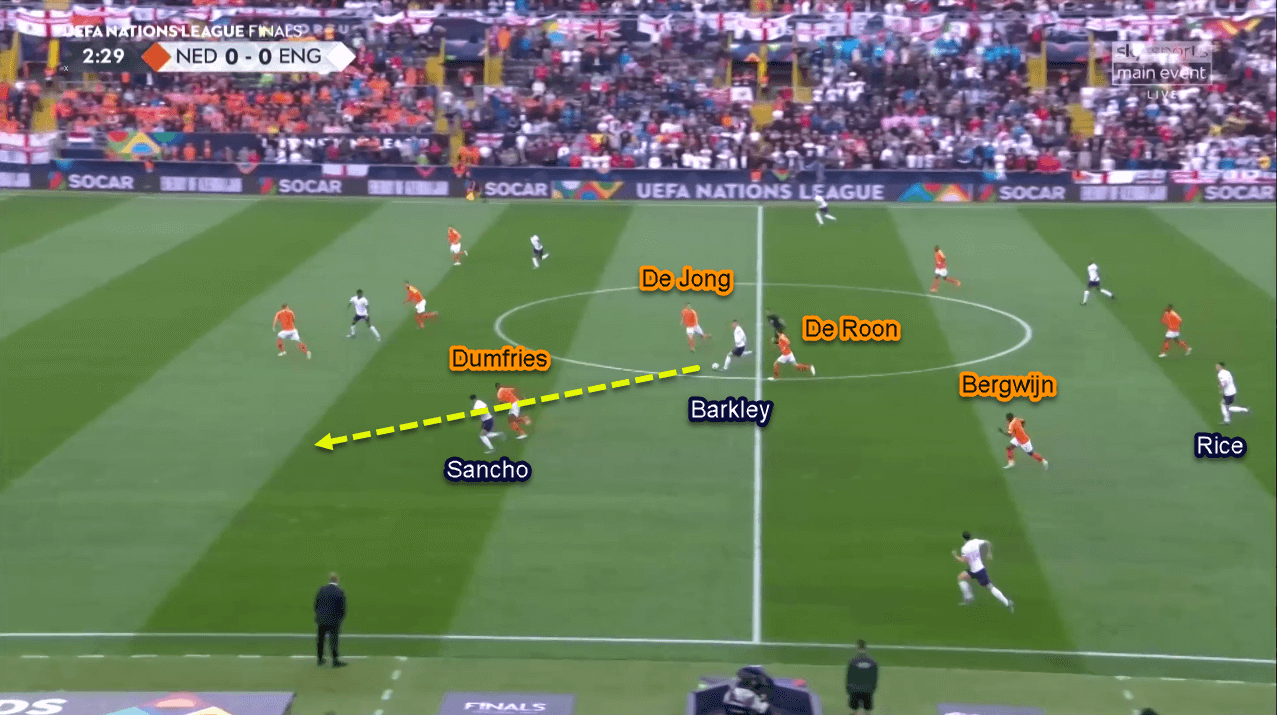
England also got another player that had good ball-carrying ability in Walker. The aggressive full-back possesses the ability to defeat his opponent in a one-versus-one duel and bring the ball forward with pace. For one time, he dribbled past Babel and roamed into the space opened by Delph’s smart movement, which pulled de Jong out of his position in the process. It was his decision-making that let his team down because he couldn’t find his open teammates in the perfect time; therefore ending England’s attack prematurely. The same sequence didn’t happen again until the end of the match.
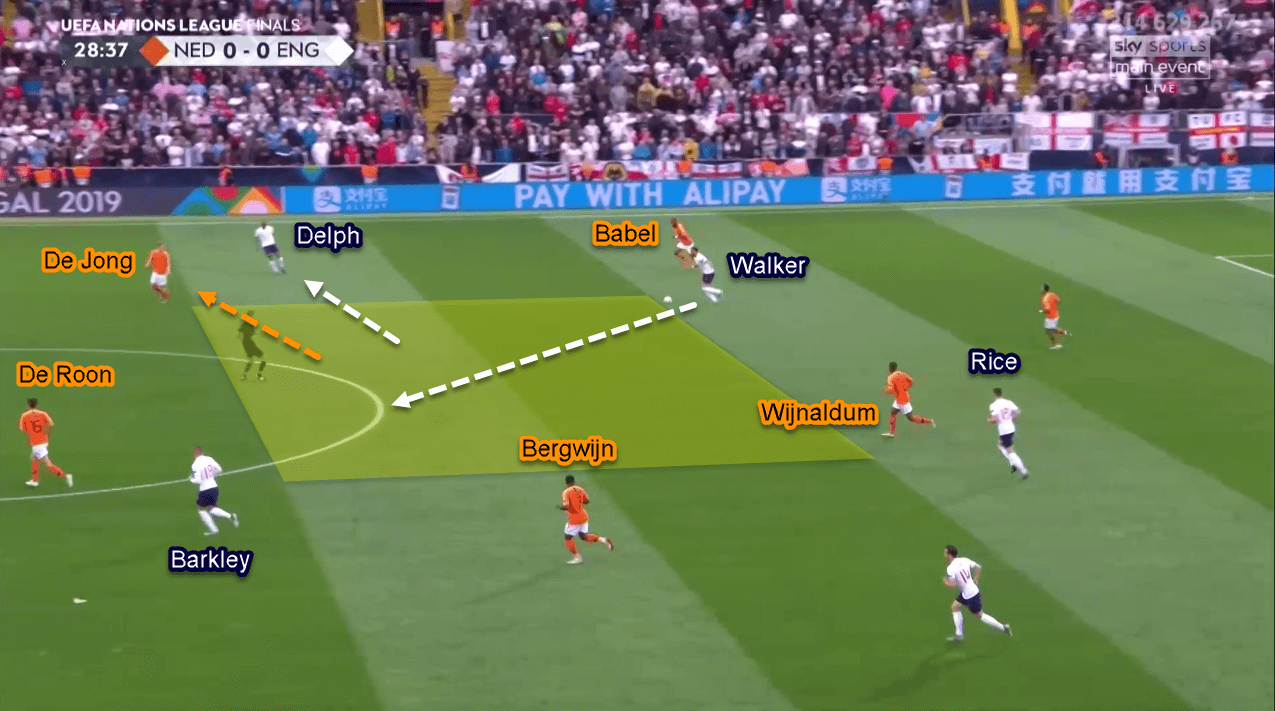
Cometh the hour, …
Despite still being 19 years old, de Ligt has impressed the football world with his maturity and leadership skill. However, the young defender was the man to blame for England’s opening goal after he made a costly mistake. Rashford capitalised on de Ligt’s error, slotted the earned penalty home, and gave England their lead. Nonetheless, his maturity came to display again in this game, which he proved by giving his side the equalising goal in the second half.
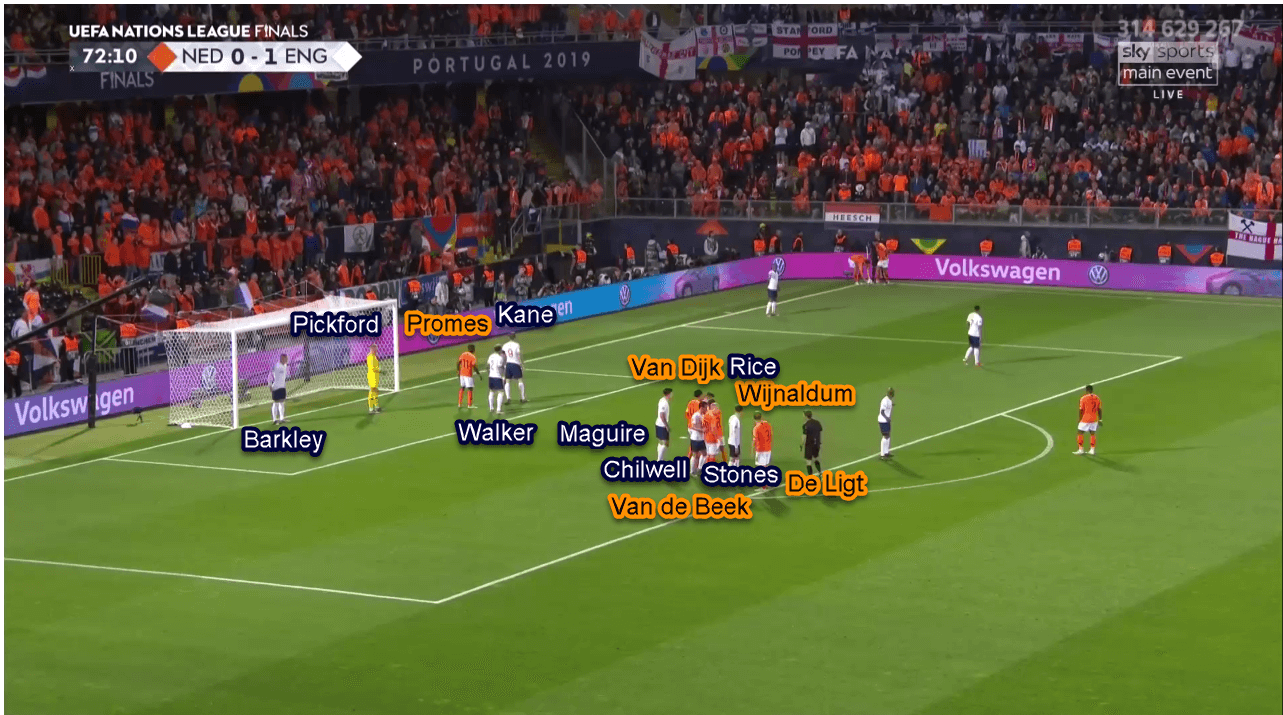
As he did previously in the Champions League against Juventus, de Ligt once again scored a thumping header to restore his team’s morale. Defensively, England went for a hybrid of zonal and man-marking. First, they did that by putting four men against four Netherlands players in the edge of the box; Maguire on van Dijk, Rice on Wijnaldum, Chilwell on Donny van de Beek, and Stones on de Ligt. Then England add three players to defend zonally in the six-yard box; Kane, Walker, and Barkley against Promes. The objective of that hybrid shape was to slow down the Netherlands’ quartet while having additional support if the ball reaches the goalmouth.
…, cometh de Ligt
In this corner-kick sequence, Netherlands ran an Ajax-esque routine which made de Ligt as their main target. Ironically, the routine’s set-up was a bit similar to what England had in the World Cup last summer; where multiple players made a ‘train’ shape in the edge of the box. The Netherlands would open a running lane for de Ligt by tasking van Dijk to screen Stones, so the Manchester City defender couldn’t follow the Ajax defender into the dangerous area.
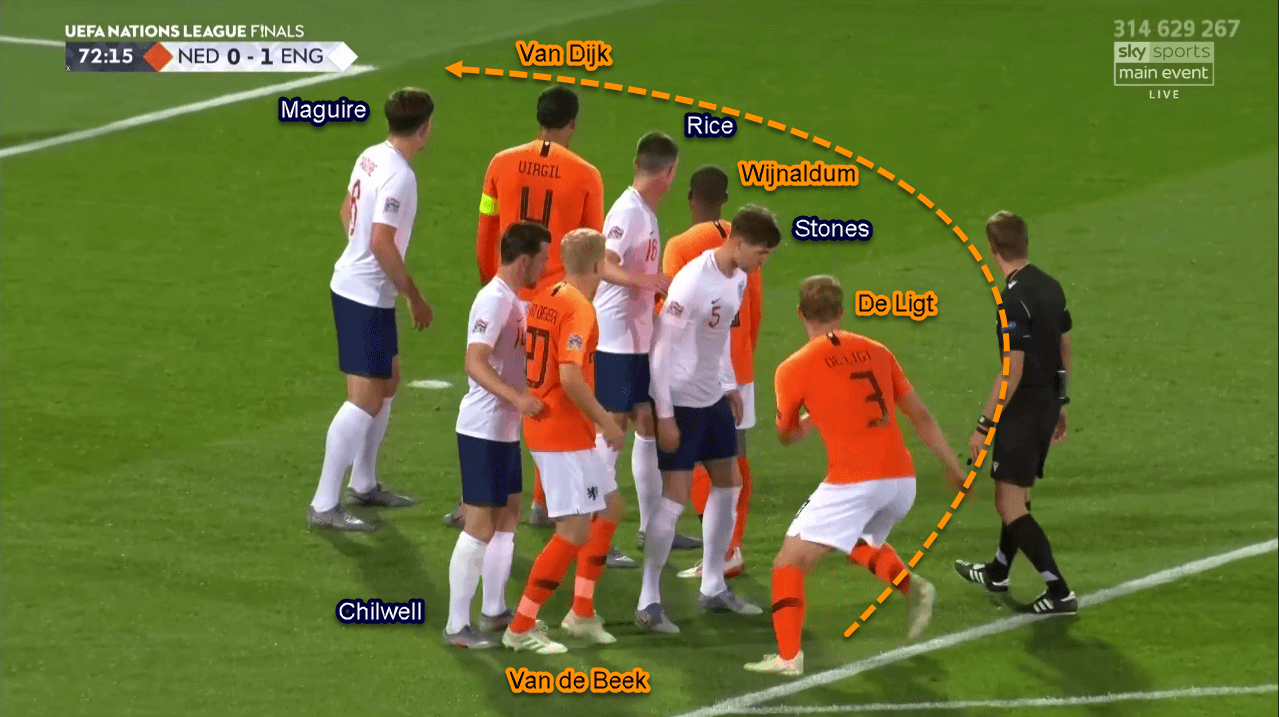
Nevertheless, it was almost not needed. De Ligt timed his curved run really brilliantly to attack the ball; even before van Dijk realising his move. De Ligt caught Stones napping, made his curved run, and ascended above everyone to head the ball in. Stones did follow him but he was too late, while Walker had no physicality whatsoever to match de Ligt’s.
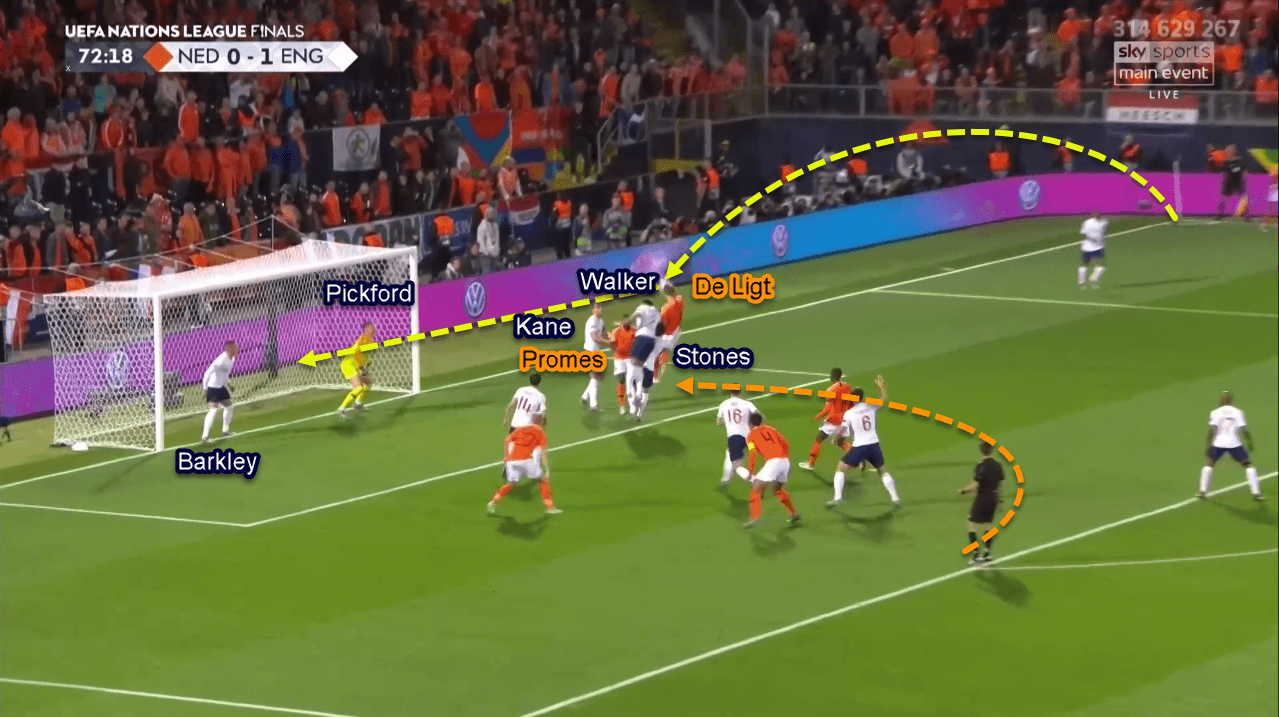
Furthermore, a question must be asked for Southgate because of his decision to put smaller Chilwell instead of the more physical Kane or Barkley in the man-marking scheme; even though Chilwell couldn’t do much in this scenario. Maybe Southgate should have put Kane or Barkley in Walker’s position, instead of putting them nearby the posts. The reason was again simply because they possess more physical presence than the defender.
Second half adjustments
In the second half, both teams changed their shapes once again. The Netherlands changed first by moving into 4–2–3–1. In the 4–2–3–1, Koeman tasked his wingers to tuck inside and play between the lines. Koeman also gave the freedom for his attackers to rotate themselves, so they could damage England’s defence easier. Another instruction he gave was for Memphis to drop more often and help the midfielders in build-ups; as Dumfries and Blind were more restricted due to the shape change.
England reacted by shaping themselves in 4–4–2. In this shape, they hoped that they could decrease the amount of space in between the lines and prevented the Netherlands from playing there. Additionally, by putting two forwards and two wingers they could mirror the Netherlands’ backline shape and prevented them from building their plays swiftly.
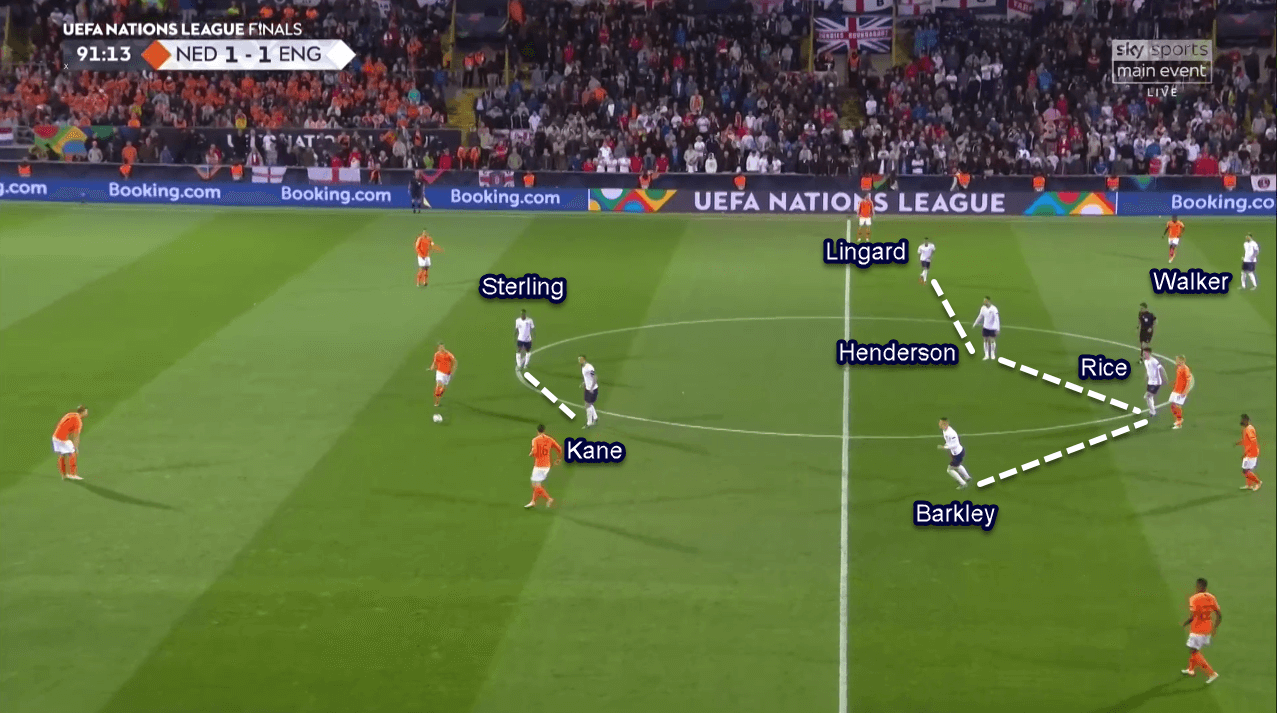
However, the Netherlands prevailed in this war of adjustments. Their narrow forwards were able to outsmart England’s new shape. By making an overload in between the lines, they killed two birds with one stone. First, they could combine easier and therefore allowing more chances to be created.
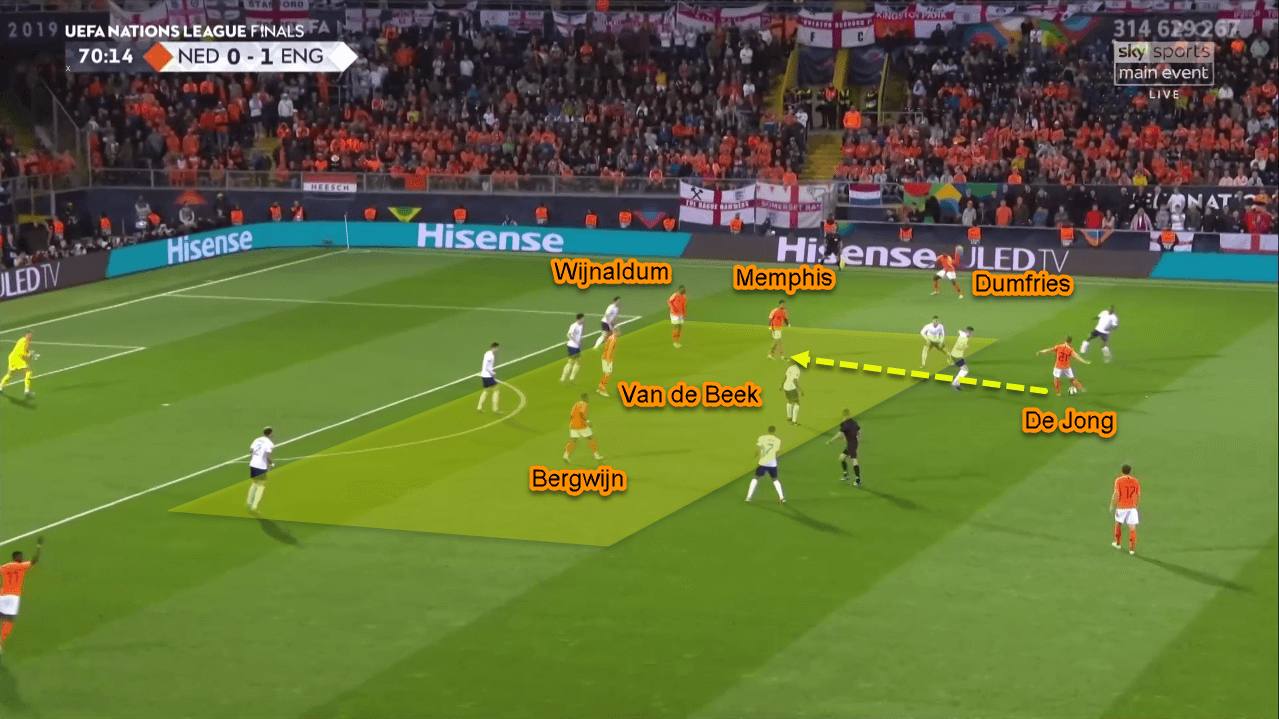
Second, the decision to tuck the wingers in gave Netherlands’ full-backs more space to roam; with Dumfries as the usual target and van Dijk as the main diagonal passer. This happened because Chilwell and Sterling would follow their opponents inside; in order to prevent them from breaking through England’s block. However, neither of the attackers or Dumfries capitalised on those advantages due to their poor quality in the final third.
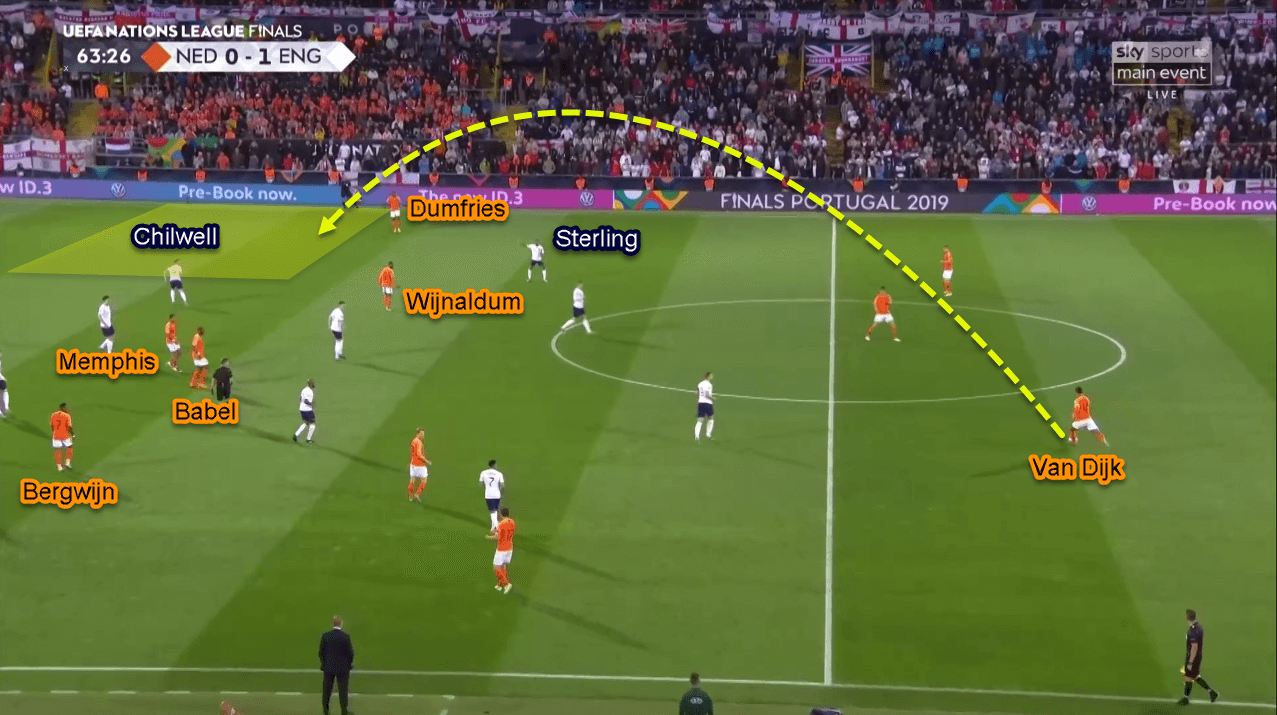
England’s offensive issues
Later in the game, England opted to use a similar approach as the Netherlands; focusing to exploit the area between the lines. They capability of Kane, Sterling, Jesse Lingard, and later Alli, was the reason Southgate picked the approach. However, that approach didn’t work for The Three Lions due to the defensive approach of Netherlands’ defenders.
As mentioned before, De Oranje’s defenders liked to step up and engage in a one-versus-one duel against their opponents’ strikers in between the lines. This was very different if we compare to the English defenders. The Englishmen would like to sit deeper, protect the space, and sacrifice their bodies to block the shots; very different with Netherlands’ aggressive defending.
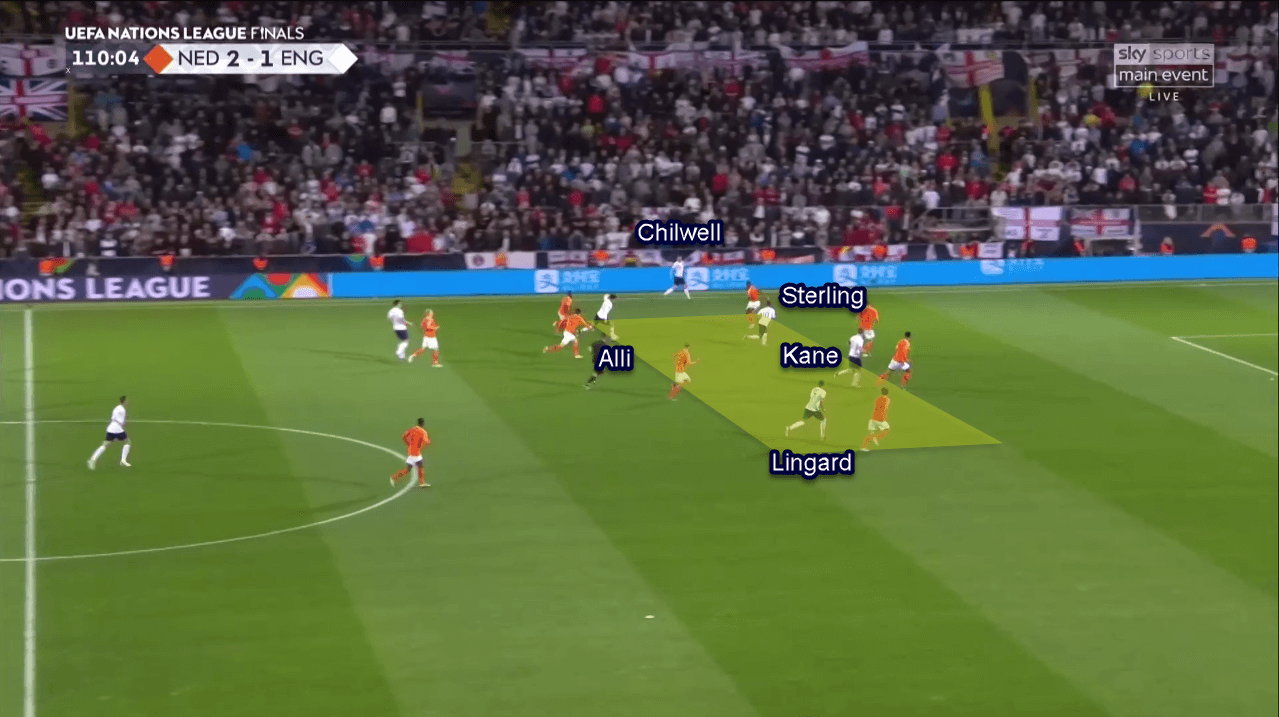
Against such type of defending, England should have played more passes in behind. This is because aggressive defending tend to open more space in between the defenders. By saying that, Southgate should have instructed one or two of his attackers to make runs in behind; with Sterling and Lingard as his possible options.
As stated in the early part of this piece, England did some damage to the Netherlands’ defence by playing that way through Sancho’s run. Even more, The Three Lions did score with that approach late in the normal time via Lingard; until it was ruled out for offside by VAR. However, Southgate chose not to do that and had to accept the consequences.
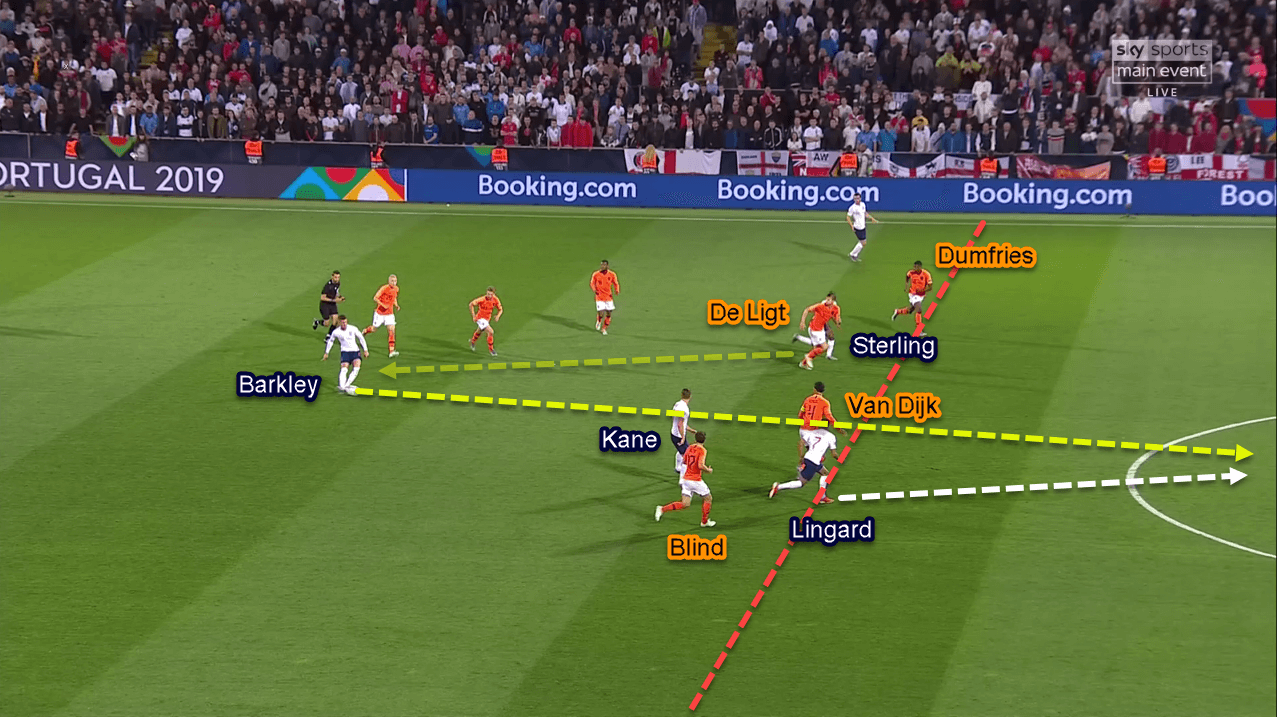
Conclusion
This game displayed a good tactical battle from both managers, which won by Koeman due to his great tactical adaptability. On top of that, credits must be given to the Netherlands squad who showed great discipline and consistency for 120 minutes. In the other side, Southgate’s naivety and Stones’ multiple defensive errors make England have to wait at least another year for their international triumph.
Portugal are already waiting in the final. With a whole country to face this weekend, can the Netherlands deliver another masterclass? Let’s see.
If you love tactical analysis, then you’ll love the digital magazines from totalfootballanalysis.com – a guaranteed 100+ pages of pure tactical analysis covering topics from the Premier League, Serie A, La Liga, Bundesliga and many, many more. Buy your copy of the May issue for just ₤4.99 here, or even better sign up for a ₤50 annual membership (12 monthly issues plus the annual review) right here

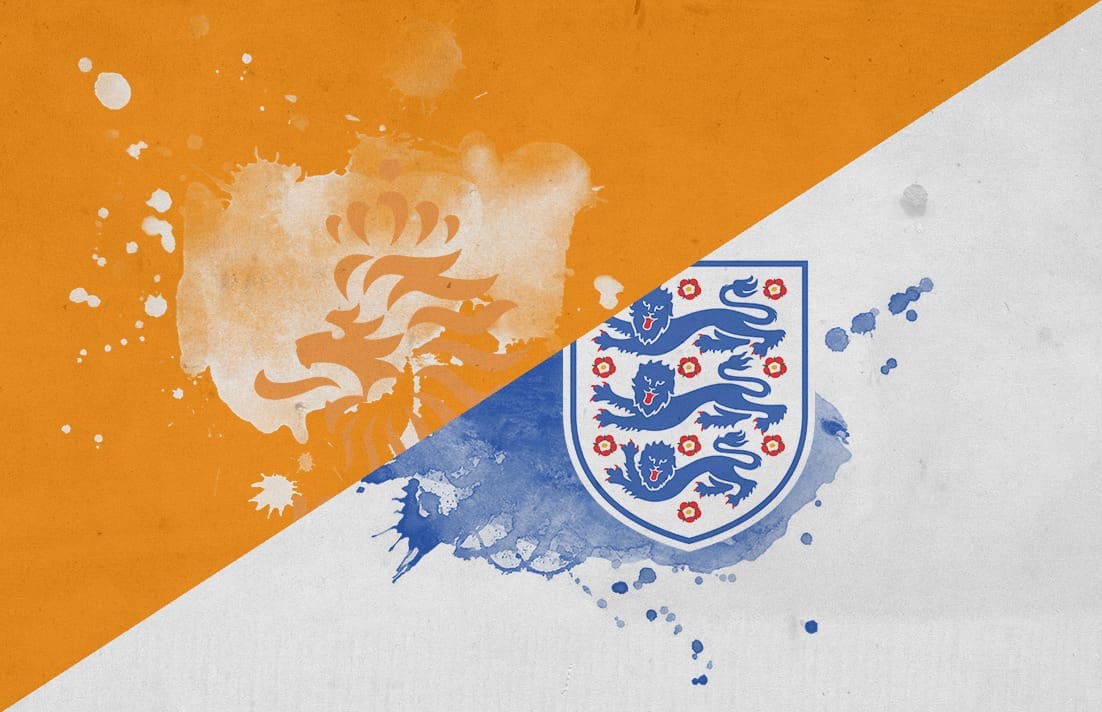



Comments